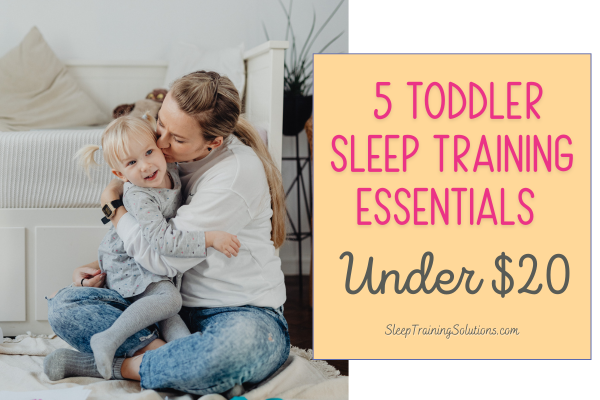5 Toddler Sleep Training Essentials Under $20
Top Toddler Sleep Training Tools Every Parent Should Try
Getting a toddler to sleep well often comes down to consistency and a few clever tools. In my pediatric sleep coaching experience, I’ve seen that a simple, predictable bedtime routine supported by the right gear can make all the difference. Here are five affordable items (all under $20) that are great (and in many cases, necessary!) tools to use for toddler sleep.
1. Cozy Bedtime Books
Reading to your toddler before bed is more than just sweet bonding time – it’s a proven sleep strategy.
Experts note that being read a story at bedtime helps preschoolers fall asleep faster, stay asleep longer, and even resist bedtime less.
A physical book is ideal because it won’t emit any blue light, which can suppress melatonin. I always recommend picking two board books or picture books to read to your child at bedtime.
Time for Bed was a favorite in my house for many years – its rhyming text and sweet animal illustrations help your child start to wind down during the bedtime routine. All of the bedtime stories on my fav list are well under $20 - most in the $5-8 range!
👉 Click here to see my full list of favorite bedtime books!
2. Bedtime Routine Chart
Toddlers thrive on predictability, and a simple routine chart can turn an abstract bedtime ritual into a concrete plan. Having a visual cue for each step helps to keep your child on task and helps with stalling - cutting down on “one more drink” or “just one more book” delays because they can see the steps that have already been checked off
A magnetic chart or picture chart that lists each step (bath, pajamas, teeth brushing, stories, etc.) with fun icons lets your child “own” their routine. They can mark off each completed step, or you can simply point to them as you go. This not only adds a bit of fun, but it acts as a visual reminder that bedtime tasks are done one by one.
For under $10, you can get this magnetic bedtime routine board with steps you can customize for the steps in your child’s routine. It makes the whole bedtime process feel like a game plan, and removes a lot of guesswork for a busy toddler!
3. Toddler “OK-to-Wake” Clock
Whether it’s dawn or an early wakeup, toddlers don’t yet know when to stay in bed. A color-changing toddler clock (often called an “ok-to-wake” clock) solves this by using lights as cues. You program it so that the clock glows one color (say, red or yellow) to mean “nighttime, stay in bed,” and another color (green) to mean “okay to get up.”
Toddlers learn quickly: “When the light is red, I stay in bed until it turns green!”
This simple toddler clock is under $20 and a solid option. If you have the budget for one over $20, my recommendation is to use this toddler clock that just has so many great features - white noise, can control through an app, easy to set up and use for both nighttime and naps. As a sleep consultant, a toddler clock is the #1 tool that, along with a good strategy, helps reduce (and eventually eliminate) middle of the night and early-morning wanderings.
4. Visual Countdown Timer
How many times have you said, “we’re leaving in 5 minutes” and then you respond to an email, realize the laundry needs to be switched to the dryer, etc. and it ends up being MUCH longer than 5 minutes? Young children have no innate sense of minutes or clocks, and we, as adults, aren’t consistent when we talk about time, so saying “5 more minutes” often means nothing to them!
A visual countdown timer turns time into a visible countdown. This visual timer has a big dial that shows a bright disc shrinking as time passes. You might say, “When this timer is done, it’s time to brush teeth and start bedtime.” Seeing the red disk count down helps toddlers understand “when the timer ends, the activity is over.”
The visual timer gives your child a concrete end point for playtime, so they stop thinking of bedtime as coming “suddenly.” You can use it for some many situations - starting the bedtime routine, getting out of the bath, getting out the door in the morning for preschool, etc. With consistent use, the timer becomes a reliable cue that helps move things along without a meltdown.
5. Portable Blackout Shades
A dark room is essential to make bedtime easier and help push early wakings later. Even a little streetlight or early sunrise can cue a toddler’s body to wake up. That’s why blackout curtains or shades are so powerful, especially in the summer months.
I’ve seen families get an extra hour or two of sleep after hanging even inexpensive blackout shades. For under $20, you can grab this portable blackout shade that sticks to your window and blocks out 100% of light. These are great if you’re renting or need a quick fix.
Bonus: Low-Blue (Amber) Nightlight
If your toddler is old enough to say they’re afraid of the dark (usually 3+ years), an amber nightlight can help. But beware: the color matters. A recent Cleveland Clinic article explains that blue light (like standard white LEDs) “significantly affect our normal melatonin production” and can disturb sleep. By contrast, a red or amber glow “doesn’t disrupt melatonin production”. In fact, Dr. Brian Chen recommends an amber (orange-red) nightlight for kids because it provides comfort without interfering with sleep hormones.
I like auto dusk-to-dawn amber night lights (like this 2-pack that’s under $20) for kids’ bedrooms because they cast a gentle warm glow and aren’t on a motion sensor. (Make sure you’re getting the amber one.) It’s just enough so your child can find the potty or feel safe, but low enough on the spectrum to preserve a good night’s sleep. (If your child doesn’t need a light, better to keep the room completely dark.)
Each of these five items – bedtime storybooks, a routine chart, a toddler clock, a visual countdown timer, and 100% blackout shades – addresses a different aspect of the bedtime puzzle. Together they create routine, cues, and environment that make sleep training much smoother. And if fear of the dark is an issue, the amber nightlight is a sleep-friendly bonus. Every tool here is under $20, but in my opinion are worth their weight in gold!
How to Help Your Toddler Sleep Better Without Breaking the Bank
Related Posts:
Please note that some of this site’s links are affiliate links, and Sleep Training Solutions is a participant in the Amazon Services LLC Associates Program, an affiliate advertising program designed to provide a means for sites to earn advertising fees by advertising and linking to Amazon.com and affiliated websites. I will earn a small commission, at no additional cost to you, if you purchase them.
This post is for informational purposes only and may not be the best fit for you, your child and/or your personal situation. It shall not be construed as medical advice. The information and education provided here is not intended or implied to supplement or replace professional medical treatment, advice, and/or diagnosis. Always check with your child’s physician or medical professional before trying or implementing any information read here.





